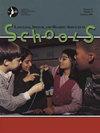远程麦克风支持语言障碍儿童在噪音和混响中的语音识别。
IF 2.9
3区 医学
Q1 AUDIOLOGY & SPEECH-LANGUAGE PATHOLOGY
Language Speech and Hearing Services in Schools
Pub Date : 2024-12-26
DOI:10.1044/2024_lshss-24-00018
引用次数: 0
摘要
目的:听力正常且有各种语言和认知障碍的儿童在背景噪音中处理语言时会遇到困难。因此,患有语言障碍(LD)的儿童在较差的声学环境中存在语音识别困难的风险。方法比较有混响和无混响背景语音噪声(SSN)对典型语言发育(TLD)和有混响背景语音噪声(SSN)的儿童句子识别的影响。n = 9)。我们还调查了使用远程麦克风(RM)是否改善了LD儿童的语音识别。结果LD儿童在SSN中表现出比TLD儿童更差的句子识别。两组使用SSN +混响的句子识别率均低于单独使用SSN。值得注意的是,在SSN和SSN +混响中,使用RM改善了LD儿童的语音识别。我们讨论了教育意义和未来的研究问题,以确定如何在嘈杂环境中最佳地支持ld儿童的语音识别。补充材料https://doi.org/10.23641/asha.28037984本文章由计算机程序翻译,如有差异,请以英文原文为准。
Remote Microphones Support Speech Recognition in Noise and Reverberation for Children With a Language Disorder.
PURPOSE
Children with typical hearing and various language and cognitive challenges can struggle with processing speech in background noise. Thus, children with a language disorder (LD) are at risk for difficulty with speech recognition in poorer acoustic environments.
METHOD
The current study compared the effects of background speech-shaped noise (SSN) with and without reverberation on sentence recognition for children with LD (n = 9) and typical language development (TLD; n = 9). We also investigated whether the use of a remote microphone (RM) improved speech recognition for children with LD.
RESULTS
Children with LD demonstrated poorer sentence recognition than peers with TLD in SSN. Both groups had poorer sentence recognition with SSN + reverberation than SSN alone. Notably, using an RM improved speech recognition for children with LD in SSN and SSN + reverberation.
CONCLUSION
We discuss educational implications and future research questions to identify how to optimally support speech recognition in noisy environments for children with LD.
SUPPLEMENTAL MATERIAL
https://doi.org/10.23641/asha.28037984.
求助全文
通过发布文献求助,成功后即可免费获取论文全文。
去求助
来源期刊

Language Speech and Hearing Services in Schools
Social Sciences-Linguistics and Language
CiteScore
4.40
自引率
12.50%
发文量
165
期刊介绍:
Mission: LSHSS publishes peer-reviewed research and other scholarly articles pertaining to the practice of audiology and speech-language pathology in the schools, focusing on children and adolescents. The journal is an international outlet for clinical research and is designed to promote development and analysis of approaches concerning the delivery of services to the school-aged population. LSHSS seeks to advance evidence-based practice by disseminating the results of new studies as well as providing a forum for critical reviews and meta-analyses of previously published work.
Scope: The broad field of audiology and speech-language pathology as practiced in schools, including aural rehabilitation; augmentative and alternative communication; childhood apraxia of speech; classroom acoustics; cognitive impairment; craniofacial disorders; fluency disorders; hearing-assistive technology; language disorders; literacy disorders including reading, writing, and spelling; motor speech disorders; speech sound disorders; swallowing, dysphagia, and feeding disorders; voice disorders.
 求助内容:
求助内容: 应助结果提醒方式:
应助结果提醒方式:


